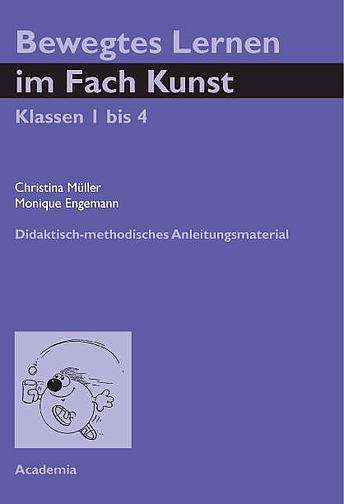Müller | Engemann
Bewegtes Lernen im Fach Kunst
ISBN 978-3-89665-284-3
englischChildren need physical activity to develop their personality harmonically. Physical activity is the medium to realize and create environment (comp. Grupe 1982, 72) Physical activity enables young people to have a more sophisticated look at their environment and they gather various information. Physical activity supports cognitive learning (improved ability to concentrate, an additional access for information through the 'sense of emotion', getting the optimum out of the process of digesting information, and others). Moving situations supply various occasions for social learning to the learning groups. Thereby giving and taking is being realized in a well-balanced way. Moreover, there is a cohesion between both satisfying movements and positive emotional experiences. On the one hand physical activity can activate but on the other hand it can help to relax and decrease stress. This advances health and well being. Physical activity is a condition for a healthy physical development. Since people feel safer while moving the number of accidents can be decreased. The testing of different movements, a realistic evaluation of one's own qualities, and the experience of one's own abilities and boarders result in a much more satisfying life.
Children are not physically active enough because they are addicted to their individual conditions characterized by a world that is more and more hostile towards movement. So called 'sitting lessons' support the suppression of movement. Therefore, schools should leave more space to the physical activities of children and manage a learning with all senses; including the 'sense of movement'. It should become a school in motion.
Since 1998 a collection of file cards of learning in motion in mathematics, German, and social studies have been used successfully by a number of teachers. Now an extension to the lessons in Arts is going to follow.
In a preface the meaning of physical activity to children's development is being explained and the structure of its criteria are being introduced. In the following collection of examples a lot of experiences, ideas and additions of primary school teachers and university lecturers were used. This methodical material shows the actual existence of learning in motion in the Arts lessons with the following aims:
- Additional access for information are to be opened up, e.g. by touching art and the environment, experiencing connections between colour and shape by movement, forming and creating pictures, plastics and sculptures by moving the entire body.
- The process of digesting information can be optimised by memorizing basic knowledge while passing on an object, talking about different possibilities of shaping an object while walking or while changing seats.
- Learning in motion also helps to prevent children from sitting in one position for too long. In addition, it can increase the pleasure in learning. Moreover, pupils are to connect independent learning with movement. They are to look for new variations and to work with a partner.
Kinder brauchen die Bewegung, um sich in ihrer Gesamtpersönlichkeit harmonisch entwickeln zu können. Bewegung ist das Medium, die Umwelt zu erkennen und zu gestalten (vgl. Grupe 1982, 72). Durch Bewegung nehmen die Heranwachsenden ihre Umwelt differenzierter wahr und sammeln vielfältige Erfahrungen. Bewegung unterstützt das kognitive Lernen (verbesserte Konzentrationsfähigkeit, zusätzlicher Informationszugang über den 'Bewegungssinn', Optimierung der Informationsverarbeitung u. a). Bewegungssituationen bieten für Schülergruppen vielfältige soziale Lernmöglichkeiten, bei denen die Wechselseitigkeit von Geben und Nehmen ausgewogen realisiert wird. Des Weiteren besteht ein Zusammenhang zwischen als befriedigend erfahrenen Bewegungshandlungen und positivem emotionalen Erleben. Bewegung kann einmal aktivieren, hat aber auch eine beruhigende und stressabbauende Wirkung. Dadurch werden Gesundheit und Wohlbefinden gefördert. Bewegung ist eine Voraussetzung für die motorische und gesunde körperliche Entwicklung. Durch Bewegungssicherheit kann die Unfallhäufigkeit gesenkt werden. Die Erprobung von Bewegungsabläufen, eine realistische Selbsteinschätzung und das Erleben eigenen Könnens, aber auch eigener Grenzen, tragen wesentlich zu einer befriedigenden Selbsterfahrung bei.
Kinder haben aber zu wenig Bewegung, denn sie sind in Abhängigkeit von ihren individuellen Bedingungen von einer zunehmend von Bewegungseinschränkungen charakterisierten Welt umgeben. Der Zustand dauernder Bewegungsunterdrückung wird noch verstärkt durch einen den Schulalltag häufig bestimmenden typischen 'Sitzunterricht'. Deshalb sollte Schule insgesamt den Bewegungsaktivitäten der Kinder mehr Raum bieten und konsequent ein Lernen mit allen Sinnen, also auch dem 'Bewegungssinn', ermöglichen und zu einer bewegten Schule werden.
Nachdem bereits seit 1998 die Karteikartensammlungen zum bewegten Lernen in den Fächern Mathematik, Deutsch und Sachunterricht von einer Reihe von Lehrern erfolgreich eingesetzt wird, erfolgt nun einer Erweiterung auf das Fach Kunst.
In einem Vorwort wird die Bedeutung der Bewegung für die kindliche Entwicklung erläutert und die Strukturierung der Auswahlkriterien vorgestellt. In die sich anschließende Sammlung von Beispielen flossen umfangreiche Erfahrungen, Ideen und Ergänzungen vor allem von Grundschullehrern sowie von Fachdidaktikern ein. Das didaktisch-methodische Anleitungsmaterial zeigt Konkretisierungen für bewegtes Lernen im Fach Kunst mit folgenden Zielstellungen auf:
- Zusätzliche Informationszugänge sollen erschlossen werden, z. B. durch das Wahrnehmen sinnlich erfassbarer Erscheinungen in der Kunst und Umwelt über den Körper, das Erfahren von Farb- und Formbeziehungen über Bewegungshandlungen, das Formen und Gestalten von Bildern, Plastiken, Skulpturen mittels Ganzkörperbewegungen.
- Die Informationsverarbeitung kann optimiert werden durch das Einprägen von Grundkenntnissen beim Weitergeben eines Gegenstandes, das Informieren über Gestaltungsmöglichkeiten beim Gehen durch den Raum oder beim Wechseln der Plätze.
- Bewegtes Lernen hilft auch Haltungskonstanz zu vermeiden und kann die Lernfreude steigern. Des Weiteren sollen die Schüler zunehmend selbstständig Lernen mit Bewegung verbinden, neue Varianten suchen und mit einem Partner zusammenarbeiten.


